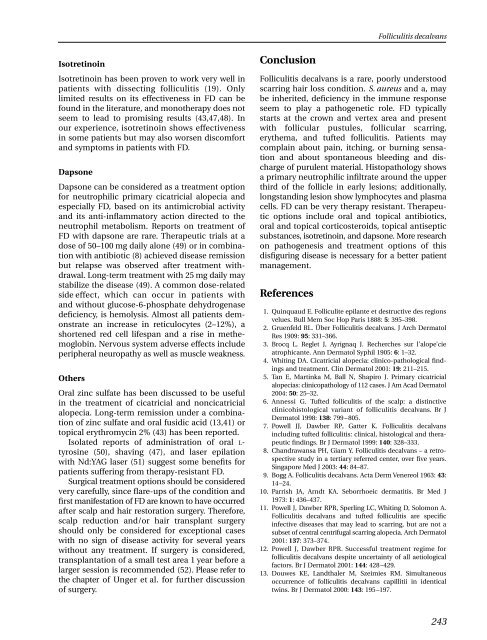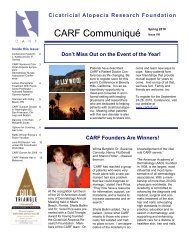Folliculitis decalvans - Cicatricial Alopecia Research Foundation
Folliculitis decalvans - Cicatricial Alopecia Research Foundation
Folliculitis decalvans - Cicatricial Alopecia Research Foundation
You also want an ePaper? Increase the reach of your titles
YUMPU automatically turns print PDFs into web optimized ePapers that Google loves.
Isotretinoin<br />
Isotretinoin has been proven to work very well in<br />
patients with dissecting folliculitis (19). Only<br />
limited results on its effectiveness in FD can be<br />
found in the literature, and monotherapy does not<br />
seem to lead to promising results (43,47,48). In<br />
our experience, isotretinoin shows effectiveness<br />
in some patients but may also worsen discomfort<br />
and symptoms in patients with FD.<br />
Dapsone<br />
Dapsone can be considered as a treatment option<br />
for neutrophilic primary cicatricial alopecia and<br />
especially FD, based on its antimicrobial activity<br />
and its anti-inflammatory action directed to the<br />
neutrophil metabolism. Reports on treatment of<br />
FD with dapsone are rare. Therapeutic trials at a<br />
dose of 50–100 mg daily alone (49) or in combination<br />
with antibiotic (8) achieved disease remission<br />
but relapse was observed after treatment withdrawal.<br />
Long-term treatment with 25 mg daily may<br />
stabilize the disease (49). A common dose-related<br />
side effect, which can occur in patients with<br />
and without glucose-6-phosphate dehydrogenase<br />
deficiency, is hemolysis. Almost all patients demonstrate<br />
an increase in reticulocytes (2–12%), a<br />
shortened red cell lifespan and a rise in methemoglobin.<br />
Nervous system adverse effects include<br />
peripheral neuropathy as well as muscle weakness.<br />
Others<br />
Oral zinc sulfate has been discussed to be useful<br />
in the treatment of cicatricial and noncicatricial<br />
alopecia. Long-term remission under a combination<br />
of zinc sulfate and oral fusidic acid (13,41) or<br />
topical erythromycin 2% (43) has been reported.<br />
Isolated reports of administration of oral<br />
tyrosine (50), shaving (47), and laser epilation<br />
with Nd:YAG laser (51) suggest some benefits for<br />
patients suffering from therapy-resistant FD.<br />
Surgical treatment options should be considered<br />
very carefully, since flare-ups of the condition and<br />
first manifestation of FD are known to have occurred<br />
after scalp and hair restoration surgery. Therefore,<br />
scalp reduction and/or hair transplant surgery<br />
should only be considered for exceptional cases<br />
with no sign of disease activity for several years<br />
without any treatment. If surgery is considered,<br />
transplantation of a small test area 1 year before a<br />
larger session is recommended (52). Please refer to<br />
the chapter of Unger et al. for further discussion<br />
of surgery.<br />
L<br />
-<br />
Conclusion<br />
<strong>Folliculitis</strong> <strong>decalvans</strong><br />
<strong>Folliculitis</strong> <strong>decalvans</strong> is a rare, poorly understood<br />
scarring hair loss condition. S. aureus and a, may<br />
be inherited, deficiency in the immune response<br />
seem to play a pathogenetic role. FD typically<br />
starts at the crown and vertex area and present<br />
with follicular pustules, follicular scarring,<br />
erythema, and tufted folliculitis. Patients may<br />
complain about pain, itching, or burning sensation<br />
and about spontaneous bleeding and discharge<br />
of purulent material. Histopathology shows<br />
a primary neutrophilic infiltrate around the upper<br />
third of the follicle in early lesions; additionally,<br />
longstanding lesion show lymphocytes and plasma<br />
cells. FD can be very therapy resistant. Therapeutic<br />
options include oral and topical antibiotics,<br />
oral and topical corticosteroids, topical antiseptic<br />
substances, isotretinoin, and dapsone. More research<br />
on pathogenesis and treatment options of this<br />
disfiguring disease is necessary for a better patient<br />
management.<br />
References<br />
1. Quinquaud E. Folliculite epilante et destructive des regions<br />
velues. Bull Mem Soc Hop Paris 1888: 5:<br />
395–398.<br />
2. Gruenfeld RL. Über <strong>Folliculitis</strong> <strong>decalvans</strong>. J Arch Dermatol<br />
Res 1909: 95:<br />
331–366.<br />
3. Brocq L, Reglet J, Ayrignaq J. Recherches sur l’alope’cie<br />
atrophicante. Ann Dermatol Syphil 1905: 6:<br />
1–32.<br />
4. Whiting DA. <strong>Cicatricial</strong> alopecia: clinico-pathological findings<br />
and treatment. Clin Dermatol 2001: 19:<br />
211–215.<br />
5. Tan E, Martinka M, Ball N, Shapiro J. Primary cicatricial<br />
alopecias: clinicopathology of 112 cases. J Am Acad Dermatol<br />
2004: 50:<br />
25–32.<br />
6. Annessi G. Tufted folliculitis of the scalp: a distinctive<br />
clinicohistological variant of folliculitis <strong>decalvans</strong>. Br J<br />
Dermatol 1998: 138:<br />
799–805.<br />
7. Powell JJ, Dawber RP, Gatter K. <strong>Folliculitis</strong> <strong>decalvans</strong><br />
including tufted folliculitis: clinical, histological and therapeutic<br />
findings. Br J Dermatol 1999: 140: 328–333.<br />
8. Chandrawansa PH, Giam Y. <strong>Folliculitis</strong> <strong>decalvans</strong> – a retrospective<br />
study in a tertiary referred center, over five years.<br />
Singapore Med J 2003: 44:<br />
84–87.<br />
9. Bogg A. <strong>Folliculitis</strong> <strong>decalvans</strong>. Acta Derm Venereol 1963: 43:<br />
14–24.<br />
10. Parrish JA, Arndt KA. Seborrhoeic dermatitis. Br Med J<br />
1973: 1:<br />
436–437.<br />
11. Powell J, Dawber RPR, Sperling LC, Whiting D, Solomon A.<br />
<strong>Folliculitis</strong> <strong>decalvans</strong> and tufted folliculitis are specific<br />
infective diseases that may lead to scarring, but are not a<br />
subset of central centrifugal scarring alopecia. Arch Dermatol<br />
2001: 137: 373–374.<br />
12. Powell J, Dawber RPR. Successful treatment regime for<br />
folliculitis <strong>decalvans</strong> despite uncertainty of all aetiological<br />
factors. Br J Dermatol 2001: 144:<br />
428–429.<br />
13. Douwes KE, Landthaler M, Szeimies RM. Simultaneous<br />
occurrence of folliculitis <strong>decalvans</strong> capillitii in identical<br />
twins. Br J Dermatol 2000: 143: 195–197.<br />
243



